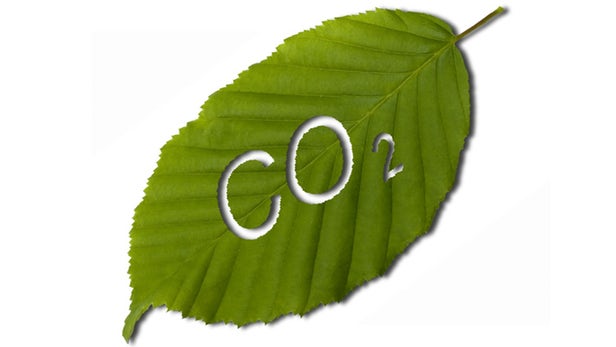Solar-powered molecule converts CO2 into carbon-neutral fuel source

Inspired by the leaf, researchers have developed a molecule that uses sunlight to convert CO2 into CO(Credit: BoValentino/Depositphotos)
The humble leaf, which collects sunlight and uses that energy to turn carbon dioxide into fuel for the plant, has inspired scientists to create various systems that could turn the greenhouse gas into fuels, using bacteria, engineered microorganisms, chemical reactors or a catalyst of copper and carbon. Now, researchers at Indiana University (IU) have developed a molecule that uses sunlight to convert the problematic carbon dioxide into carbon monoxide, which can then be stored as a fuel source.
While it's not a widely-used fuel by itself, carbon monoxide has other industrial tricks up its sleeve, and can be used to create other fuels. The IU team's new molecule essentially boasts a more efficient way to convert carbon dioxide into carbon monoxide, expending only solar power. When the resulting fuel is ultimately burned, the same amount of carbon dioxide is released as went into making it, turning it into a "carbon-neutral" fuel source.
"Carbon monoxide is an important raw material in a lot of industrial processes," says Liang-shi Li, lead researcher on the study. "It's also a way to store energy as a carbon-neutral fuel since you're not putting any more carbon back into the atmosphere than you already removed. You're simply re-releasing the solar power you used to make it."
The team claims its technique is the most energy-efficient way to create carbon monoxide, and it comes down to the molecule at the center of the reaction. This molecule is made of nanographene and rhenium, which form two parts of a tiny machine: the nanographene absorbs sunlight and sends the energy to the rhenium atom, which acts like an "engine" that reduces carbon dioxide to carbon monoxide.
"If you can create an efficient enough molecule for this reaction, it will produce energy that is free and storable in the form of fuels," says Li. "This study is a major leap in that direction."
Similar systems based on organic compounds and metals have been used in carbon reduction processes before, but they typically can only capture a small wedge of the light spectrum. Using nanographene as the energy collector, the researchers say their molecule can make use of a larger section of the visible light spectrum, at wavelengths of up to 600 nm. The original idea came from earlier research into using nanographene to improve the efficiency of solar cells.
"We asked ourselves: Could we cut out the middle man – solar cells – and use the light-absorbing quality of nanographene alone to drive the reaction?" says Li.
The team tested the molecule with concentrated CO2, at levels much higher than the 400 parts per million (ppm) that is present in Earth's atmosphere. In theory, the researchers say it should function at normal concentrations, too, but more work is needed to test that out.
"There are people working with low-concentration of CO2, and this should be doable with our catalyst as well," Li tells New Atlas. "At this early stage it is hard to say using what pressure of CO2 makes more practical sense. High pressure of CO2 is not hard to get (e.g., in carbon sequestration). It consumes energy to get it, but would make the CO2 reduction faster. So clearly there will be some optimization and compromise needed in the future."
The researchers believe there's also room for improvement in the efficiency of the molecule itself. To that end, they plan to replace the relatively-rare metal, rhenium, with a more common alternative, manganese. The molecule's power and longevity is also in line for a tune-up, as the team attempts to turn it into a solid catalyst.
The research was published in the Journal of the American Chemical Society.
Source: Indiana University
